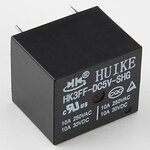maniac84
Full Member level 6
Hi guys...
I have a relay application like the circuit below.

My relay spoils after around 100 times of ON/OFF only.
My question is, is my design create lot's of voltage spike when turning ON/Off the relay? Is it the spike that caused my relay spoils?
I have put the diode to suppress the spike. Does it work?
How do we extend the life of the relay?
I have a relay application like the circuit below.

My relay spoils after around 100 times of ON/OFF only.
My question is, is my design create lot's of voltage spike when turning ON/Off the relay? Is it the spike that caused my relay spoils?
I have put the diode to suppress the spike. Does it work?
How do we extend the life of the relay?
